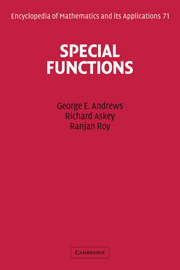Book contents
- Frontmatter
- Contents
- Preface
- 1 The Gamma and Beta Functions
- 2 The Hypergeometric Functions
- 3 Hypergeometric Transformations and Identities
- 4 Bessel Functions and Confluent Hypergeometric Functions
- 5 Orthogonal Polynomials
- 6 Special Orthogonal Polynomials
- 7 Topics in Orthogonal Polynomials
- 8 The Selberg Integral and Its Applications
- 9 Spherical Harmonics
- 10 Introduction to q-Series
- 11 Partitions
- 12 Bailey Chains
- A Infinite Products
- B Summability and Fractional Integration
- C Asymptotic Expansions
- D Euler–Maclaurin Summation Formula
- E Lagrange Inversion Formula
- F Series Solutions of Differential Equations
- Bibliography
- Index
- Subject Index
- Symbol Index
3 - Hypergeometric Transformations and Identities
Published online by Cambridge University Press: 05 May 2013
- Frontmatter
- Contents
- Preface
- 1 The Gamma and Beta Functions
- 2 The Hypergeometric Functions
- 3 Hypergeometric Transformations and Identities
- 4 Bessel Functions and Confluent Hypergeometric Functions
- 5 Orthogonal Polynomials
- 6 Special Orthogonal Polynomials
- 7 Topics in Orthogonal Polynomials
- 8 The Selberg Integral and Its Applications
- 9 Spherical Harmonics
- 10 Introduction to q-Series
- 11 Partitions
- 12 Bailey Chains
- A Infinite Products
- B Summability and Fractional Integration
- C Asymptotic Expansions
- D Euler–Maclaurin Summation Formula
- E Lagrange Inversion Formula
- F Series Solutions of Differential Equations
- Bibliography
- Index
- Subject Index
- Symbol Index
Summary
Gauss's work on the hypergeometric equation contains a discussion of the monodromy question for the solutions of this equation. Gauss found and analyzed a quadratic transformation of hypergeometric functions; this apparently led him to the problem of monodromy. Unlike the linear (fractional) transformations of these functions, of which Pfaff's formula in Theorem 2.2.5 is an example, quadratic transformations exist only under certain conditions on the parameters. Nevertheless, they are important and useful. We have given some applications of these transformations after deriving a few basic formulas. An interesting application deals with the problem of proving Gauss's arithmetic-geometric mean to be expressible as an elliptic integral.
This chapter also contains a discussion of some methods for the summation of certain types of hypergeometric series. We use a quadratic transformation to obtain Dixon's identity for a well-poised 3F2 at x = 1. We then apply a method of Bailey to derive identities for special types of p+1Fp with 2 ≤ p ≤ 6, including Dougall's identity, which was mentioned in Remark 2.2.2 in the previous chapter. An important transformation formula due to Whipple is obtained by the same method. Just as Barnes's integral on the product of gamma functions was an analog of Gauss's 2F1 sum, these identities also have integral analogs and we discuss them. The hypergeometric identities provide a systematic approach to the evaluation of single sums of binomial coefficients.
Information
- Type
- Chapter
- Information
- Special Functions , pp. 124 - 186Publisher: Cambridge University PressPrint publication year: 1999
